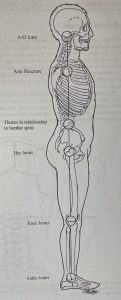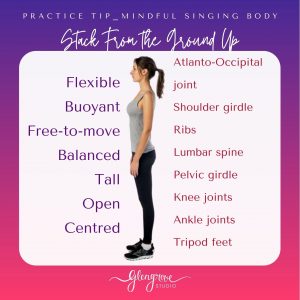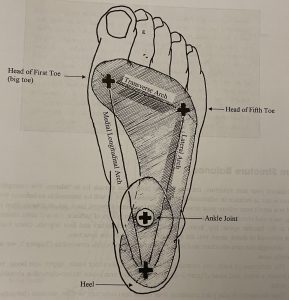“What you can do you can imagine, and what you can imagine you can do.”
Moshe Feldenkrais
Your body is an engineering marvel!
With its upside-down weight distribution, it is elegantly designed to resist gravity when your skeleton holds you up and your muscles move you about and enable you to function.
And this very same body IS your musical instrument! Not just your larynx and your neck, more even than your lungs…but also your brain and ENTIRE nervous system. An injury to just about any part of your body can alter the way you hold and use your body, and that can affect your singing.
Even using the wrong parts of your body to help you defy gravity can generate altered function or excess tension, and invariably alter the way you are singing.
This blog is the second in a 4-part series which aims to explore the way your voice is the interface between mind, heart, body and soul. We will explore how this interface can give your singing wings, your confidence strength and your storytelling sparkle.
Take a moment…
How are you using your body right now?
Do you feel balanced, tall, open and centred?
Kinesthetic Awareness vs Posture
In this section, we’re going to look at 3 terms and their role in mindful singing:
- posture
- body mapping
- kinaesthesia
Posture
I try not to use the word posture in singing lessons. Instead I’ve found it really useful to look at patterns of movement in each individual human body. Exploring options rather than finding fixed habits.
“Posture means stasis or standing perfectly still (one root of posture is positura, meaning ‘a position’, and another is ponere or ‘to place’). Singing, however, always requires movement, so the word posture can be antithetical to excellent singing.”
Mary-Jean Allen
It is more important to be curious about your own perception of your body than it is to aim for perfect “posture”. As long as it is accurate, your body map can be either conscious or subconscious to be effective. Therefore, considering anatomical facts and how they are applied to your singing is important.
Body Mapping
The concept of “body mapping” is useful here…as what we believe about our body, its use and its potential or limitations, usually influences how we go about many activities. Since most of the body parts used for singing are inside our skin and unable to be observed, our sense of what they are like governs how we recruit them for music making.
“A body map is your mental representation of your body’s size, structure, and function…Because your body map governs your movement, you move according to what you believe about your body…for instance, singers would need a detailed, accurate map of their ribs, lungs and diaphragm.”
Mary-Jean Allen
I love Kristen Linklater’s observation that what is familiar to us may not necessarily be the same as what is natural to us. For example, my diaphragm is naturally designed to descend as my ribs expand, enabling my lungs to follow suit and fill with oxygen. The descent of the diaphragm naturally causes the displacement of abdominal organs and muscles. However, if I have been trained as a dancer, the way that I hold my abdomen will resist that displacement…so the natural sensations described above do not feel familiar.
“…the tensions acquired through living in this world, as well as defenses, inhibitions and negative reactions to environmental influences, often diminish the efficiency of the natural voice to the point of distorted communication. …there is a vital difference to be observed between what is “natural” and what is “familiar”….The natural voice is transparent, it reveals, not describes, inner impulses of emotion and thought, directly and spontaneously. The person is heard, not the person’s voice.”
Kristin Linklater
Take a moment…
If you were to list the parts of your body that play a role in singing and speaking, what percentage of your body would that make up?
A good place to begin a review of your body map is to consider the six points of balance in your skeleton.

As you correct and refine your body map by learning how to embody the six places of balance, your singing will improve in the following ways:
- Release unnecessary tension
- More buoyant and flexible
- More beautiful, full and resonant tone quality
- Improved breath management
- Greater ease along fast passages
- More authentic singing and actng
- Improved acting and stage gesturing

Kinesthesia
“Kinesthesia is the perception of your body in motion; how it moves, where it moves, and the quality of that movement…Therefore, your kinesthetic sense is as essential as your other five senses, and all singers must learn how to use it.”
Malde, Allen, Zeller
I read somewhere that it’s better to think about body movement and positions as though you are standing in a spotlight. All of you being perceived as one entity. It’s really easy to focus on one area of the body at a time, as though you’re pointing a hand held torch at it. So you see it in isolation like it’s separate from the rest of you.
As you contemplate individual areas of your body, like the feet in this tripod exercise, try to keep “sight” of your whole body in the picture. And not just the front of you, where your eyes face…what do you sense in back of you as well?
Our eyes love to dominate the sensory stocktake … perhaps try closing them during some safe moments (not while you’re driving ;-)… and allow your other senses to play a stronger role
Take a moment…
Reflect on how you use your feet by doing the following tripod exercise.

As you study the diagram, notice that the head of your big toe, the head of your fifth toe and your heel all form a tripod. When you distribute your weight equally on these three areas of the foot tripod, the balance of your entire body will improve. (Malde et al)
Download two tripod exercises here.
Feldenkrais Method
There are several wonderful kinaesthetic awareness methods (many of which are taught at performing arts institutions) that I could discuss here, but I’m only mentioning the Feldenkrais Method because that is the one I am intimately familiar with. I have been taking lessons in this method since 2012. It has helped me through exhausting rehearsals and performances as a conductor and repetiteur; through thousands of teaching hours; and through mountains of self-discovery about how I walk, sleep, sit, stand, drive…. you get the idea.
“This Method works with habits and patterns of movement – in the case of singers it would be standing as well as singing. By honing your awareness and your attention, you learn about your movement patterns – its efficiency, ease, limitations and so on, so you can gather more options. So rather than just the one habit (which may not be the best or optimal) you can expand to several ways of moving that won’t available previously.”
Cassandra Morrow, Feldenkrais Practitioner
When I first tried it, I didn’t really understand what was happening…it was so subtle, gentle and slow. Was I actually getting my money’s worth? And yet I never walked out the same way I walked in. My breathing shifted. My relationship with the ground shifted. And the more I had these glimpses into ease of movement, the more I wanted it.
And the more ease of movement and openness I experienced, the more AMAZING my vocal resonance and airflow became. We’ve all heard the buzz words around neuroplasticity or brain plasticity…well, I guess I have been experiencing that!
You could think of this method as a series of gentle, small, repeated movements designed to allow your nervous system to gather data on how it’s functioning. Comparing left and ride sides; before and after; range of motion. And the more I attend to this internal observation, the more my subconscious brings my attention back to it during busy times. I might suddenly become aware that I’m holding my breath while I’m typing this blog, or straining the small of my back. And then I can make a choice to remain in that position, or find a more comfortable one.
I will mention that including moments of pause or rest during the steps of the exercises is vital as it is allowing the brain time to assimilate what your senses are becoming aware of. And anyway, we push ourselves through so much busy-ness in life, I don’t need telling twice to take a break!
If you’d like to read more about Moshe Feldenkrais or the Feldenkrais method, visit here or here. I hope to write more about my experiences in the future.
What’s next?
The next mini-blog on mindful singing will move into practical steps you can take during your singing practice. Obviously, this kinesthetic awareness will be a growing part of your singing for the rest of your life. Until the next blog, I hope your observations about your body bring your joy and a plethora of a-ha moments!
Happy singing!
If you enjoyed these tips and ideas, why not sign up for the Glengrove Studio newsletter.
To subscribe, click here or click on the NEWSLETTER SIGN-UP button at the top of this webpage.
Sources
Conversations and Feldenkrais lessons with qualified practitioner Cassandra Morrow.
Linklater, K. (2006). Freeing the Natural Voice: Imagery and art in the practice of voice and language. Nick Hern Books, London
Malde, M., Allen, M. & Zeller, K. (2009). What Every Singer Needs to Know About the Body. Plural Publishing, San Diego
Marshall, L. (2008). The Body Speaks: Performance and physical expression (2nd Ed.) Bloomsbury, London
Morton, J. 2015. The Authentic Performer: wearing a mask and the effect on health. Compton Publishing, Oxford
Nelson, S. & Blades-Zeller, E. (2002). Singing with Your Whole Self: The Feldenkrais method and voice. Scarecrow Press, Maryland